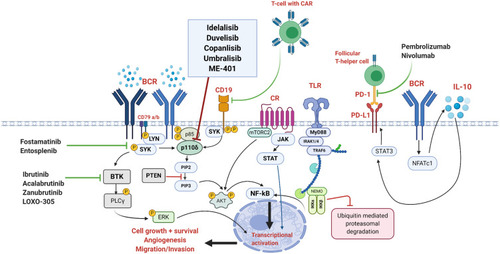Figures & data
Figure 1 The PI3K pathway in the context of BCR signaling along with various targets. The BCR pathway is activated through antigen binding followed by recruitment and stimulation of LYN/SYK, resulting in phosphorylation of tyrosine residues on adapter proteins on the BCR as well as CD19. This enables the docking of PI3K regulator subunit to the BCR and CD19 and activation of the PI3K pathway. Activated PI3K phosphorylates PIP2 into PIP3 which stimulates PH domain signaling molecules including Akt. LYN/SYK also activate the BTK pathway which instigates PLCγ2 activation. The result of these processes is intranuclear transcriptional activation promoting cell survival. PTEN is a prominent negative regulator of this pathway. Also shown is the role of follicular T-helper cells and the PD-1/PDL-1 pathway. Created with BioRender.com.

Table 1 Ongoing Phase III Trials Studying Copanlisib in NHL
Table 2 Efficacy and Safety Profile of PI3K Inhibitors in FL

